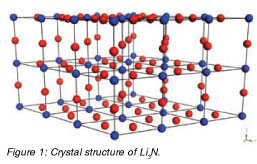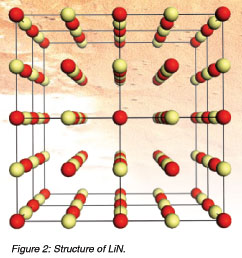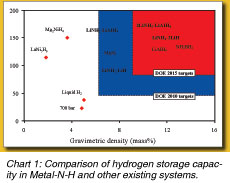|
by Ping CHEN
 o address concerns about global climate change, urban pollution, and energy security, scientists have been increasing their efforts to change the current carbon-based energy system into a so-called hydrogen-based economy. Their interest in fuel cell technologies, already established for some time, has revived because an urgent need exists for clean energy breakthroughs in hydrogen storage technology. o address concerns about global climate change, urban pollution, and energy security, scientists have been increasing their efforts to change the current carbon-based energy system into a so-called hydrogen-based economy. Their interest in fuel cell technologies, already established for some time, has revived because an urgent need exists for clean energy breakthroughs in hydrogen storage technology.
Hydrogen, the simplest and most abundant element in the universe, contains more energy on a weight-for-weight basis than any other substance; however, as the lightest element it also has very low-volume energy density. Conventional options for hydrogen storage include the high-pressure hydrogen tank and the liquid hydrogen Dewar (a vacuum flask that holds liquefied hydrogen). Both methods suffer significant energy penalties, however; compressing and liquefying the gas consumes 20% and 40% of stored energy, respectively.
 Scientists believe that chemically bonding hydrogen to lightweight elements, or solid-state hydrogen storage, holds the most promise in meeting the application targets, namely, high volumetric and gravimetric energy density. Scientists believe that chemically bonding hydrogen to lightweight elements, or solid-state hydrogen storage, holds the most promise in meeting the application targets, namely, high volumetric and gravimetric energy density.
In July 2003, the US Department of Energy (DOE) issued a Grand Challenge to the global scientific community for research and development in hydrogen storage. Researchers have put tremendous effort into this area the past few years. DOE has set targets that materials for onboard hydrogen-storage systems should have reversible 6wt% hydrogen-loading storage capacity (i.e., hydrogen stored should be of about 6% weight of the storage system, including the materials and the container) by 2010 and 9wt% by 2015. In addition to high storage capacity, researchers must optimise other parameters like operation temperature, hydrogen absorption/desorption (release) kinetics, safety, cost, cycle-life, and so on in the materials development.
 A team at the Faculty of Science, National University of Singapore (NUS), started research on hydrogen storage materials in 1998. In 2001, they accidentally found that a nitrogen-pretreated lithium-carbon nanotube (Li-CNT) intercalated compound can reversibly store a substantial amount of hydrogen at temperatures above 200°C. Subsequent investigations revealed that the hydrogen is actually stored in lithium nitride (Li3N), formed by reacting lithium in Li-CNT with nitrogen. The structure of Li3N is illustrated in Figure 1. A team at the Faculty of Science, National University of Singapore (NUS), started research on hydrogen storage materials in 1998. In 2001, they accidentally found that a nitrogen-pretreated lithium-carbon nanotube (Li-CNT) intercalated compound can reversibly store a substantial amount of hydrogen at temperatures above 200°C. Subsequent investigations revealed that the hydrogen is actually stored in lithium nitride (Li3N), formed by reacting lithium in Li-CNT with nitrogen. The structure of Li3N is illustrated in Figure 1.
The chemical reaction between lithium nitride and hydrogen leads to the formation of lithium amide (LiNH2) and lithium hydride (LiH), by which the solid phase can store up to about 10.5wt% hydrogen. Li3N thereby can store about 40% more hydrogen than magnesium (Mg) hydride, the best-known hydrogen storage material to date. Hydrogen gets released again with the decrease of hydrogen pressure. The final dehydrogenated solid residue is again lithium nitride, thus rendering the overall reaction a reversible process.
The NUS scientists published a description of their Metal-N-based hydrogen storage compounds that could meet the requirements for onboard hydrogen storage in Nature. As a consequence, national laboratories, industrial R&D centres, and universities worldwide have invested substantial effort into understanding the mechanism of hydrogen storage and developing new Metal-N-H systems.
For exceptionally high hydrogen storage capacity, hydrogenation and dehydrogenation of Li3N require relatively high operation temperatures, above 250°C, too high for practical application. Thus thermodynamic and kinetic modifications are needed for the Li-N-H system.
The NUS team discovered that by substituting other elements for a part of the Li in the system, they could significantly modify the reaction thermodynamics; for example, when they partially substituted Li for Mg in the Li-N-H system, the dehydrogenation temperature shifted downwards to about 100°C. More interestingly, if they can overcome the kinetic barrier for the hydrogen desorption, the Li-Mg-N-H system can release more than 5wt% hydrogen even at temperatures below 90°C, which fall close to the operational temperature of a proton-exchange membrane (PEM) fuel cell. Considerable activity is ongoing in the catalytic modifications and system optimisations. Various material substitutions lead to different chemical compositions and storage properties.
 Among the wide range of ternary and multinary systems under investigation, the group members favour Li-Al-N-H. Experimental results demonstrate that when they mix LiNH2 and LiAlH4 mechanically, about 6wt% of hydrogen can be desorbed even close to ambient temperature. Thermodynamic analysis reveals that when they optimise the system, the hydrogen storage capacity can reach up to 8wt% and 9.5wt% for LiAlH4-LiNH2 and LiAlH4-2LiNH2, respectively. Among the wide range of ternary and multinary systems under investigation, the group members favour Li-Al-N-H. Experimental results demonstrate that when they mix LiNH2 and LiAlH4 mechanically, about 6wt% of hydrogen can be desorbed even close to ambient temperature. Thermodynamic analysis reveals that when they optimise the system, the hydrogen storage capacity can reach up to 8wt% and 9.5wt% for LiAlH4-LiNH2 and LiAlH4-2LiNH2, respectively.
In addition to continuous efforts in developing promising new materials for hydrogen storage, an in-depth understanding of the underlying chemical reactions will greatly enhance materials-design capability and enrich the chemistry of Metal-N-containing compounds. The NUS group therefore has established links with a worldwide network of collaborators with different research strengths and with access to some highly advanced techniques for materials analyses. The researchers are currently expanding their study to include a broader range of materials to create a viable hydrogen storage system for fuel cells that will provide clean, renewable energy.
 Click here to download the full issue for USD 6.50 Click here to download the full issue for USD 6.50
|


 o address concerns about global climate change, urban pollution, and energy security, scientists have been increasing their efforts to change the current carbon-based energy system into a so-called hydrogen-based economy. Their interest in fuel cell technologies, already established for some time, has revived because an urgent need exists for clean energy breakthroughs in hydrogen storage technology.
o address concerns about global climate change, urban pollution, and energy security, scientists have been increasing their efforts to change the current carbon-based energy system into a so-called hydrogen-based economy. Their interest in fuel cell technologies, already established for some time, has revived because an urgent need exists for clean energy breakthroughs in hydrogen storage technology.
 Scientists believe that chemically bonding hydrogen to lightweight elements, or solid-state hydrogen storage, holds the most promise in meeting the application targets, namely, high volumetric and gravimetric energy density.
Scientists believe that chemically bonding hydrogen to lightweight elements, or solid-state hydrogen storage, holds the most promise in meeting the application targets, namely, high volumetric and gravimetric energy density.
 A team at the Faculty of Science, National University of Singapore (NUS), started research on hydrogen storage materials in 1998. In 2001, they accidentally found that a nitrogen-pretreated lithium-carbon nanotube (Li-CNT) intercalated compound can reversibly store a substantial amount of hydrogen at temperatures above 200°C. Subsequent investigations revealed that the hydrogen is actually stored in lithium nitride (Li3N), formed by reacting lithium in Li-CNT with nitrogen. The structure of Li3N is illustrated in Figure 1.
A team at the Faculty of Science, National University of Singapore (NUS), started research on hydrogen storage materials in 1998. In 2001, they accidentally found that a nitrogen-pretreated lithium-carbon nanotube (Li-CNT) intercalated compound can reversibly store a substantial amount of hydrogen at temperatures above 200°C. Subsequent investigations revealed that the hydrogen is actually stored in lithium nitride (Li3N), formed by reacting lithium in Li-CNT with nitrogen. The structure of Li3N is illustrated in Figure 1.
 Among the wide range of ternary and multinary systems under investigation, the group members favour Li-Al-N-H. Experimental results demonstrate that when they mix LiNH2 and LiAlH4 mechanically, about 6wt% of hydrogen can be desorbed even close to ambient temperature. Thermodynamic analysis reveals that when they optimise the system, the hydrogen storage capacity can reach up to 8wt% and 9.5wt% for LiAlH4-LiNH2 and LiAlH4-2LiNH2, respectively.
Among the wide range of ternary and multinary systems under investigation, the group members favour Li-Al-N-H. Experimental results demonstrate that when they mix LiNH2 and LiAlH4 mechanically, about 6wt% of hydrogen can be desorbed even close to ambient temperature. Thermodynamic analysis reveals that when they optimise the system, the hydrogen storage capacity can reach up to 8wt% and 9.5wt% for LiAlH4-LiNH2 and LiAlH4-2LiNH2, respectively.
 Click here to download the full issue for USD 6.50
Click here to download the full issue for USD 6.50